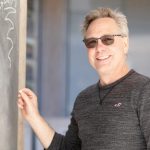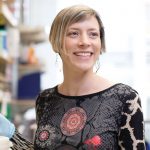Professor Joseph Ecker, along with co-first authors Florian Jupe, Angeline Rivkin, Mark Zander and Todd Michael (of the J. Craig Venter Institute) and colleagues mapped the genomes and epigenomes of genetically modified plant lines with high resolution to show what happens at a molecular level when a piece of foreign DNA is inserted. Their findings not only elucidate the routine methods used to modify plants but also offer new ways to minimize potential off-target effects.
Read News ReleaseDiscoveries
To repair DNA damage, plants need good contractors
Associate Professor Julie Law and first author Clara Bourbousse showed which genes are turned on or off, and in which order, to protect and repair the genome in response to DNA damage.
The research reveals the genetic framework controlling a complex biological process that has broad implications for understanding how plants in particular, and organisms in general, cope with DNA damage to ensure long-term health and fitness.
Read News ReleaseHow the office org chart in your brain helps to organize your actions
Salk researchers have resolved a long-standing scientific debate about how behavior is organized in the brain. Associate Professor Xin Jin and first author Claire Geddes, a UC San Diego graduate student, discovered that learned behavior is organized in a hierarchy with multiple levels of control, offering possible new therapeutic targets for disorders that involve an inability to control one’s actions. The study used mice trained to carry out a series of lever presses in a specific order, left-left-right-right, to make the discovery.
Brain cells called astrocytes have unexpected role in brain “plasticity”
A Salk team led by Associate Professor Nicola Allen and first author Elena Blanco-Suarez showed that astrocytes—long-overlooked supportive cells in the brain—enable the brain’s plasticity, a previously unknown role for these cells. The team found that a protein secreted by astrocytes called Chrdl1 increases the number and maturity of connections between nerve cells, enabling the stabilization of neural connections and circuits once the connections finish developing. The findings could point to ways to restore connections lost due to aging or trauma.
Read News ReleaseGenetic “whodunit” for cancer gene solved
Long thought to suppress cancer by slowing cellular metabolism, the protein complex AMPK also seems to help tumors grow in some cases, confounding researchers. The lab of Professor Reuben Shaw, including first author Lillian Eichner, showed that advanced cancers can trigger AMPK’s cellular recycling signal to cannibalize pieces of the cell, supplying large lung tumors with the nutrients they need to grow, despite being far from blood vessels. Blocking AMPK in some conditions could stop the growth of advanced tumors in the most common type of lung cancer.
Read News ReleaseResearchers report new methods to identify alzheimer’s drug candidates that have anti-aging properties
Old age is the greatest risk factor for many diseases, including Alzheimer’s disease (AD) and cancer. First author and Professor David Schubert, senior author Pamela Maher and colleagues identified a unique subclass of anti-aging compounds, dubbed geroneuroprotectors. These potential AD-drug candidates slow the aging process in mice.
Read News ReleaseWhy screen time can disrupt sleep
Professor Satchin Panda, first author Ludovic Mure and colleagues pinpointed how certain cells in our eyes process ambient light and reset our internal clocks, or circadian rhythms—the daily cycles of physiological processes. When these cells are exposed to artificial light late into the night, our internal clocks can become disoriented, resulting in a host of health issues. By detailing the interactions of the light-sensitive protein melanopsin and how the eyes react to light, the research may lead to new treatments for migraines, insomnia, jet lag and circadian-rhythm disorders.
Read News ReleaseTo detect new odors, fruit fly brains improve on a well-known computer algorithm
It might seem like fruit flies would have nothing in common with computers, but Assistant Professor Saket Navlakha and collaborators from Salk and UC San Diego found that fruit flies and computers identify novel information in similar ways.
The work not only sheds light on an important neurobiological problem—how organisms detect new odors—but also could improve algorithms for novelty detection in computer science.
Maintaining the unlimited potential of stem cells
Embryonic stem cells (ESCs) are the very definition of being full of potential, given that they can become any type of cell in the body. But once they start down the process of turning into a particular type of tissue, they lose their unlimited potential. Assistant Professor Diana Hargreaves, first author Jovylyn Gatchalian and colleagues discovered a new protein complex that keeps the brakes on stem cells, allowing them to maintain their indefinite potential to become any cell type. The new complex, called GBAF, could provide a future target for regenerative medicine.
Age is more than just a number: machine learning may be able to predict if you’re in for a healthy old age
Assistant Professor Saket Navlakha and Vice President, Chief Science Officer and Professor Martin Hetzer, along with first author Jason Fleischer and colleagues, analyzed skin cells ranging from the very young to the very old and found molecular signatures that can be predictive of age. By better understanding the biological processes of aging, this work could help to address health conditions that are more common in advanced age, such as heart disease and dementia.
Read News ReleaseThriving on teamwork: new research shows how brain cells filter information in groups
For decades, scientists studying the visual system thought that neurons operated as filters. Some neurons preferred coarse details of the visual scene and ignored fine details, while other neurons did the opposite. Professor Thomas Albright, first author Ambarish Pawar and coauthors found that the same neurons that preferred coarse details were able to change to prefer finer details under different conditions. The work could help to better understand neural mechanisms that shape our perceptions of the world.
Read News ReleaseSalk scientists uncover the health effects of metabolic “magic bullet” protein
The metabolic protein AMPK has been described as a kind of magic bullet for well-being because it can improve cardiovascular health, treat mitochondrial disease and even extend life span.
Now, Professor Reuben Shaw, first author Daniel Garcia and collaborators have developed a new system that lets them study in detail exactly how, where and when AMPK carries out its molecular and therapeutic functions.
Read News ReleaseScientists reveal clues into early development of autism spectrum disorder
Autism spectrum disorder (ASD) affects roughly 1 in 59 children in the United States. Salk President and Professor Rusty Gage, first author Simon Schafer, and colleagues compared stem cells created from the skin cells of individuals with ASD against stem cells created from individuals without ASD to uncover, for the first time, measurable differences in the patterns and speed of development in the ASD-derived cells. The findings could lead to diagnostic methods to detect the disorder at an early stage.
Read News ReleaseResearch confirms nerve cells made from skin cells are a valid lab model for studying disease
Professor Joseph Ecker, co-first author Chongyuan Luo and collaborators at Stanford University and Baylor College of Medicine showed that cells induced to grow into nerve cells have molecular signatures matching neurons in the brain.
The study opens the door for better ways to model an individual patient’s disease and could help advance research into gene therapies that are derived from a patient’s own cells.
Read News ReleaseIn surprising reversal, scientists find a cellular process that stops cancer before it starts
Cells regularly break down and recycle their components in a process called autophagy. Professor Jan Karlseder, first author Joe Nassour and colleagues made a surprising discovery: autophagy—generally thought of as a survival mechanism for both cancerous and normal cells—can actually promote the death of cells, thereby preventing cancer initiation. The work reveals autophagy to be a novel tumor-suppressing pathway and suggests that treatments to block the process in an effort to curb cancer may unintentionally promote it very early on.
Read News ReleaseFeatured Stories
 Gerald Shadel explores stressed-out mitochondriaInside Salk sat down with Shadel to find out how he became interested in mitochondria, what he is driven by scientifically and what he has learned about aging along the way.
Gerald Shadel explores stressed-out mitochondriaInside Salk sat down with Shadel to find out how he became interested in mitochondria, what he is driven by scientifically and what he has learned about aging along the way. The science of agingWhat we know about longevity so far: Minimizing smoking, obesity and overeating while maximizing exercise and social interactions seem to correspond to longer and healthier lives, but not always. While many factors have been touted as panaceas for extending life–everything from adhering to a Mediterranean diet to regularly imbibing red wine–a “fountain of youth” has remained stubbornly elusive.
The science of agingWhat we know about longevity so far: Minimizing smoking, obesity and overeating while maximizing exercise and social interactions seem to correspond to longer and healthier lives, but not always. While many factors have been touted as panaceas for extending life–everything from adhering to a Mediterranean diet to regularly imbibing red wine–a “fountain of youth” has remained stubbornly elusive. Lillian Eichner: Reading the clues to fight cancerEichner began studying cancer while pursuing her PhD at McGill University in Montreal. She was drawn to the Salk Institute for her postdoctoral studies because Reuben Shaw, director of the Salk Cancer Center and a professor in Salk’s Molecular and Cell Biology Laboratory, has taken a new approach to cancer by studying the metabolic pathways of deadly tumors.
Lillian Eichner: Reading the clues to fight cancerEichner began studying cancer while pursuing her PhD at McGill University in Montreal. She was drawn to the Salk Institute for her postdoctoral studies because Reuben Shaw, director of the Salk Cancer Center and a professor in Salk’s Molecular and Cell Biology Laboratory, has taken a new approach to cancer by studying the metabolic pathways of deadly tumors.




















































